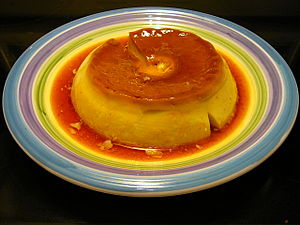Caramel: Difference between revisions
No edit summary |
No edit summary |
||
| Line 2: | Line 2: | ||
{{otheruses}} |
{{otheruses}} |
||
[[Image:Homemade Flan.jpg|thumb|300px| |
[[Image:Homemade Flan.jpg|thumb|300px|An Australian crème caramel flan that is topped with caramel.]] |
||
'''Caramel''' (/ˈkærəmɛl/ or '''Carmel''' /ˈkɑrməl/) refers to a range of [[confectionery|confection]]s that are [[beige]] to dark brown in [[color]], derived from the [[caramelization]] of one or several types of [[sugar]]s, often occurring in the traditional cooking method of a sweet. Caramel can provide the flavor in [[pudding]]s and [[dessert]]s, a filling in candies, or a topping for custards and ice creams. |
'''Caramel''' (/ˈkærəmɛl/ or '''Carmel''' /ˈkɑrməl/) refers to a range of [[confectionery|confection]]s that are [[beige]] to dark brown in [[color]], derived from the [[caramelization]] of one or several types of [[sugar]]s, often occurring in the traditional cooking method of a sweet. Caramel can provide the flavor in [[pudding]]s and [[dessert]]s, a filling in candies, or a topping for custards and ice creams. |
||
Revision as of 01:44, 24 August 2008

Caramel (/ˈkærəmɛl/ or Carmel /ˈkɑrməl/) refers to a range of confections that are beige to dark brown in color, derived from the caramelization of one or several types of sugars, often occurring in the traditional cooking method of a sweet. Caramel can provide the flavor in puddings and desserts, a filling in candies, or a topping for custards and ice creams.
Caramel is made by heating sugar slowly to around 170 °C (338 °F). As the sugar melts and approaches this temperature, the molecules break down and re-form into compounds with a characteristic caramel color and flavor. A variety of candies, confections, and desserts are made with caramel and its products: caramel apples, barley sugar, caramel with nuts (such as praline, nougat, or brittle), and caramel with custard (such as crème caramel or crème brûlée).
Caramel coloring in contrast is a dark unsweetened liquid, the highly concentrated product of near total caramelization that is bottled for commercial and industrial use. Beverages such as cola use caramel coloring, and it is also used as a food colorant. On labels in the EU, it is called E150.
Chemistry
Main article: Caramelization
Caramelization is the removal of water from a sugar, proceeding to isomerization and polymerization of the sugars into various high weight compounds. Compounds such as difructose-anhydride may be created from the monosaccharides after water loss. Fragmentation reactions result in low molecular weight compounds which may be volatile and contribute to flavor. Polymerization reactions lead to larger molecular weight compounds which contribute to dark caramel color[1].
Caramel candy

Caramel also refers to a soft, dense, chewy, caramel-flavored candy made by boiling milk, sugar, butter, vanilla essence, water, and glucose or corn syrup. Caramel candy is not heated above the firm ball stage, i.e. no more than 120 °C (248 °F). This is not high enough to cause more than negligible caramelization. This type of candy is often called milk caramel.
See also
- Dulce de leche, caramelized sweetened condensed milk
- Tablet (confectionery)
- Butterscotch a hard candy with a different flavor than caramel
- Toffee a hard, sometimes chewy candy often made with nuts
- Dodol a caramelized coconut milk confection
- Caramel apple an apple dipped in a soft caramel, sometimes coated in nuts
- Carambar, a brand of caramel candy bar
